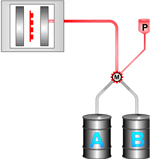Silicone offers its own set of challenges when molding into a product. There are four ways of molding silicone and each offers unique approaches:
• Extruding Molding
• Transfer Molding
• Compression Molding
• Liquid Silicone Injection Molding
All of these processes use heat as a curing technique. The silicone material varies, but all must have heat to cure (140 degrees F to 340 degrees F). We will focus on compression and liquid silicone injection molding. These molding processes are most prevalent in manufacturing silicone keypads, seals, O-rings and gaskets.
Extrude
Extrude molding is a process for making tubing or reel dispensing products. The molding machine has a continuous feed of silicone forced through a die that would have the shape of the end product. Most examples of the end product are IV tubing, cable wrap tubing and reel gaskets.
Transfer
Transfer molding is used for specially formulated silicones. The silicone is placed in a chamber and heated to a liquid, then a plunger presses the material through a sprue to a runner system and into the mold cavities that are heated. The part is removed after curing.
Compression


Silicone Injection

Material is supplied as a binary two- part system in drums that are sealed and manufactured to Six Sigma quality levels. They are catalyzed when the two parts are mixed in the molding machine. Color in the form of silicone ink can be added at the same time when the two-part system is being mixed. All settings for a part, such as custom silicone keypads, can be retained for future runs that will ensure a consistent part time and time again. Process time is about 30 seconds to 1 minute, depending on thickness of a part. Liquid silicone injection molding is a closed automated system that is repeatable with no dust or dirt.






